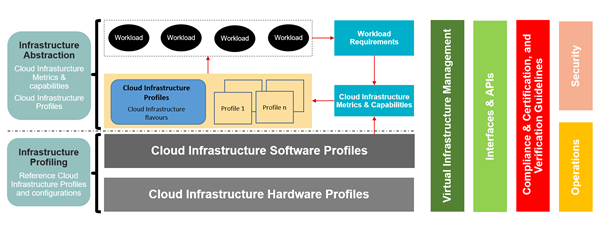Objectives
The Reference Model (RM) specifies a virtualisation technology agnostic (VM-based and container-based) cloud infrastructure abstraction and acts as a "catalogue" of the exposed infrastructure capabilities, resources, and interfaces required by the workloads. This document was originally developed by Cloud iNfrastructure Telco Taskforce (CNTT), and now is maintained and further developed by the RM sub-project of Anuket.
Problem Statement: Based on community consultations, including telco operators, technology suppliers, and software developers, there is a realisation that there are significant technical, operational and business challenges to the development and deployment of VNF/CNF network applications related to the lack of a common cloud infrastructure platform. These include but are not limited to the following:
- Higher development costs due to the need to develop virtualised/containerised network applications on multiple custom platforms for each operator.
- Increased complexities due to the need to maintain multiple versions of applications to support each custom environment.
- Lack of testing and validation commonalities, leading to inefficiencies and increased time to market. While the operators will still perform internal testing, the application developers utilising an industry standard verification program on a common cloud infrastructure would lead to efficiencies and faster time to market.
- Slower adoption of cloud-native applications and architectures. A common telco cloud may provide an easier path to methodologies that will drive faster cloud-native development.
- Increased operational overhead due to the need for operators to integrate diverse and sometime conflicting cloud platform requirements.
One of major challenges holding back the more rapid and widespread adoption of virtualised/containerised network applications is when the traditional telecom ecosystem vendors, while building or designing their virtualised services, are making their own infrastructure assumptions and requirements, often with custom design parameters. This leaves the operators being forced to build complex integrations of various vendor/function specific silos which are incompatible with each other and might possibly have different and conflicting operating models. In addition, this makes the onboarding and conformance processes of VNFs/CNFs (coming from different vendors) hard to automate and standardise. The need for a common model across the industry to facilitate more rapid adoption is clear.
Scope
This Reference Model document focuses on identifying the abstractions, and associated concepts, that are needed to represent the cloud infrastructure. The diagram below highlights its scope in more details.
This document specifies:
Cloud Infrastructure abstraction: in context with how it interacts with the other components required to build a complete cloud system that supports workloads deployed in Virtual Machines (VM) or containers. Network function workloads that are deployed on virtual machines and containers are referred to as virtual network functions (VNF) and containerised network functions (CNF), respectively; please note that it is now more common to refer CNFs as cloud native network functions.
- Cloud Infrastructure capabilities & metrics: A set of cloud infrastructure capabilities and metrics required to perform telco scale network functions and satisfy their performance criterion.
- Infrastructure profiles catalogue: A catalogue of standard infrastructure software and hardware configurations, referred to as profiles; these profiles abstract the infrastructure for the workloads. Only a few profiles, with well-defined characteristics, can meet the operational and performance requirements of all workloads.
Cloud Infrastructure Software and Hardware profiles:
- Cloud Infrastructure software profiles: These software profiles are components of the corresponding infrastructure profiles within the infrastructure profiles catalogue, and specify the host infrastructure software configurations.
- Cloud Infrastructure hardware profiles: These hardware profiles are components of the corresponding infrastructure profiles within the infrastructure profiles catalogue, and specify the host infrastructure hardware configurations.
Conformance and verification
- Conformance programs: These define the requirements for verification and validation programs for both the cloud infrastructure and workloads.
- Test framework: Provides test suites to allow conformance of cloud infrastructure and workloads.
Links to Reference Model specifications
Master copy: https://github.com/cntt-n/CNTT/tree/master/doc/ref_model
Current release (Elbrus); release date: 29 January 2021, https://github.com/cntt-n/CNTT/tree/stable/elbrus/doc/ref_model
Sign up to RM project
Work stream lead
Walter Kozlowski (Telstra) is the Works Stream Lead (WSL) for this project, email: walter.kozlowski@team.telstra.com
Regular meetings
Wednesdays @ 20:00 UTC
Link: https://zoom.us/j/997256543?pwd=MWptM0F0Y1NpckhFVUgrZnM2TkJ0Zz09
